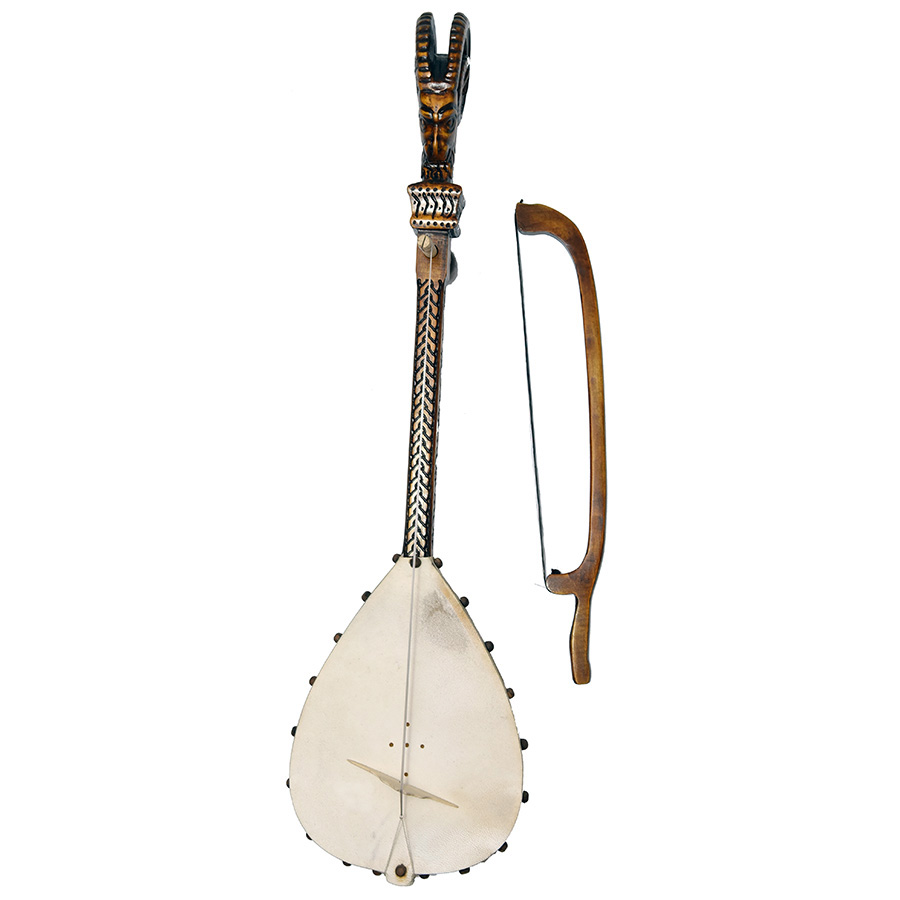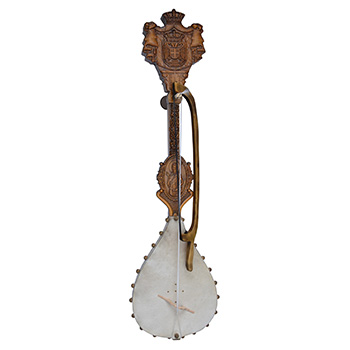Gusle
Bowed Instruments
Europe
Between 1001 and 1900 AD
Video
The Gusle is a traditional single-stringed musical instrument deeply rooted in the cultural and historical heritage of the Balkans. Known for its mournful, resonant sound, the Gusle is more than just an instrument—it is a storytelling tool, a symbol of identity, and a bridge to the past. Widely used across countries such as Serbia, Montenegro, Bosnia and Herzegovina, and parts of Croatia and Albania, the Gusle has played a pivotal role in preserving the oral traditions and collective memory of the region.
Origins and History of the Gusle
The history of the Gusle dates back to at least the 12th century, though its origins may extend further into antiquity. This instrument is believed to have evolved from earlier string instruments brought to the Balkans through interactions with Byzantine, Slavic, and Middle Eastern cultures.
Historically, the Gusle has been most closely associated with epic poetry and the oral storytelling traditions of the Balkans. In an era before widespread literacy, the Gusle was used to accompany the recitation of heroic epics, which chronicled the history, battles, and folklore of the region. These epic songs, often passed down orally from generation to generation, celebrated the deeds of historical figures, warriors, and mythical heroes.
During the period of Ottoman rule in the Balkans (14th–19th centuries), the Gusle became a symbol of resistance and national identity. Guslars (Gusle players) would perform songs that inspired unity and pride among their people, often recounting the struggles against foreign domination. This tradition solidified Gusle’s role as an instrument not only of music but also of cultural preservation and resilience.
Design and Construction of the Gusle
The Gusle is a single-stringed instrument, traditionally handcrafted from wood and animal hide. Its construction is simple yet symbolic, often reflecting the artisan’s skill and regional traditions.
- Body: The body of the Gusle is typically carved from a single piece of wood, such as maple or ash, and shaped into a resonating bowl.
- Skin: The soundboard is covered with stretched animal skin, usually from a goat, which helps amplify the sound.
- String: The single string is traditionally made from horsehair, though modern versions sometimes use synthetic materials.
- Neck and Head: The neck of the Gusle is often adorned with a decorative carving, which can include symbols such as a wolf’s head, cross, or eagle, reflecting the cultural and spiritual themes of the region.
The instrument is played with a bow strung with horsehair, and the player holds the Gusle vertically between their knees while bowing the string with one hand and adjusting the tension with the other.
Cultural Significance of the Gusle
The Gusle occupies a special place in the cultural identity of the Balkans. Its mournful tone is uniquely suited to the recitation of epic poetry, often evoking a sense of longing, pride, and connection to the past.
Epic Storytelling
The primary function of the Gusle has historically been to accompany the performance of epic songs or ballads. These songs, which could last for hours or even days, served as a living archive of history, recounting events such as the Battle of Kosovo (1389), the exploits of legendary figures like Marko Kraljević, or tales of the Hajduks (rebels who resisted Ottoman rule).
The Gusle’s role in storytelling was vital in preserving the cultural memory of the Balkans, particularly during times of foreign domination. Guslars were revered as keepers of tradition and bearers of history, ensuring that the spirit of their people endured through music and narrative.
Symbol of Identity
For many Balkan communities, the Gusle is a powerful symbol of national and cultural identity. It represents the struggles and triumphs of the region’s people, serving as a unifying force that transcends borders and political divides. The instrument is also closely tied to Orthodox Christian traditions in Serbia and Montenegro, where it is often used to perform religious and patriotic songs. Similarly, in Albania, the Gusle is known as the “lahuta” and is associated with the oral tradition of Kanun, the Albanian code of honor.
Festivals and Celebrations
The Gusle remains a prominent feature in folk festivals, weddings, and other celebrations across the Balkans. Its sound, paired with the recitation of traditional songs, continues to evoke a sense of community and cultural pride.
Modern Revival and Global Recognition
In the modern era, the Gusle has experienced a revival as part of a broader effort to preserve traditional Balkan music and culture. Folk musicians, ethnomusicologists, and cultural organizations have worked to ensure that the Gusle and its associated traditions are not forgotten. In 2018, the epic storytelling tradition of the Gusle was inscribed on the UNESCO Representative List of the Intangible Cultural Heritage of Humanity, highlighting its importance as a cultural treasure. This recognition has helped to increase awareness of the Gusle on a global scale, attracting the interest of musicians and audiences beyond the Balkans.
Today, the Gusle is featured in performances by traditional ensembles, as well as in contemporary interpretations that blend folk elements with modern genres. It continues to inspire a new generation of musicians and listeners, ensuring that its legacy endures.
FAQ
What is the origin of the Gunjac musical instrument?
The Gunjac is a traditional Croatian musical instrument with roots in rural folk traditions. It has been used historically in various regions of Croatia for accompanying dances and folk songs.
What is the significance of the Gunjac in Croatian culture?
The Gunjac holds cultural significance as a symbol of Croatian heritage, particularly in rural communities. It is often featured in traditional celebrations and festivals, preserving the unique musical identity of the region.
What are the features of the Gunjac musical instrument?
The Gunjac is typically a stringed instrument with a simple, robust design. It produces a distinctive sound that complements Croatian folk melodies. Its construction often involves locally sourced materials, reflecting the ingenuity of traditional craftsmen.
 Links
Links
References
Other Instrument
Categories



















